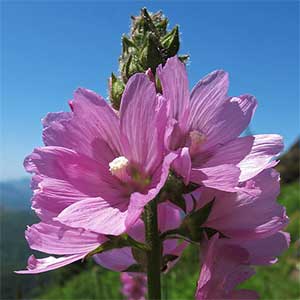Sidalcea hirtipes
Sidalcea multifida
bluff mallow, bristly-stem checker-mallow, bristly-stem checkerbloom, hairy-stem checkermallow
cut leaf checker mallow, cut-leaf checkerbloom
several, scattered, erect, arising from rhizome apices, usually slightly hollow, densely, harshly bristly-hirsute, hairs stiff, pustular, simple, forked, or stellate, often 2–2.5 mm.
clustered, usually erect or ascending, sometimes proximally decumbent or prostrate, not rooting, solid, sparsely to densely appressed stellate-hairy.
basal and cauline;
stipules linear-subulate, 6–8 × 1–1.5 mm;
petioles of proximal leaves 20–30 cm, 3 times as long as blades, reduced distally to 1/2 times as long as blades;
blades: basal and proximalmost orbiculate to reniform, shallowly 5–9-lobed, 10–15 × 10–15 cm, thick, base narrowly cordate, lobe margins coarsely crenate-dentate, apex rounded, surfaces coarsely hirsute, hairs stiff;
distal orbiculate, deeply palmately 5–7-lobed, incised ± to base, lobes sometimes lobed again, base cuneate, apex acute, deeply 2–3-toothed, surfaces long-hirsute or with 2–4-rayed, stellate hairs abaxially.
mostly basal, persistent, to 10+;
stipules linear-lanceolate to elliptic, 5–6 × 2 mm on proximal stem, 4–5 × 0.5 mm on distal stem;
petiole 5.5–16 cm, basal 3–5 times longer than blades, reduced distally to 1/2 times as long as blades;
blades: basal reniform-orbiculate, palmately (5–)7–9-lobed, deeply incised, (1.5–)2.5–4(–6) × (1.5–)2.5–4(–6) cm, base cordate, margins entire, apex rounded to acute, lobes linear to oblong, again deeply pinnately or ternately 3–5-lobed;
cauline ternately lobed, lobes linear to filiform, narrowest on distalmost leaves, somewhat fleshy, surfaces hairy, hairs appressed, stellate;
distalmost leaf lobes unlobed.
erect, spiciform to subcapitate, dense, calyces usually conspicuously overlapping in flower and sometimes in fruit, proximals usually long-pedunculate, unbranched or branched, 20+-flowered, 10+ flowers usually open on spike at same time, not interrupted, not 1-sided, usually to 8 cm, usually not elongate but sometimes slightly elongated in some populations and to 20 cm in fruit;
bracts paired or single, linear, distal undivided, proximal distinct to base, 6 mm, mostly slightly longer than pedicels.
erect, open, calyces not conspicuously overlapping except sometimes in bud, usually unbranched, usually 3–9(–15)-flowered, elongate, 1-sided, to 7–25 cm;
bracts usually paired, linear or lanceolate to narrowly ovate, proximal divided to base, distalmost 2-fid or simple, 5 mm, shorter to longer than pedicels.
1–3(–5) mm;
involucellar bractlets absent.
3–8(–10) mm;
involucellar bractlets absent.
bisexual or unisexual and pistillate, plants gynodioecious;
calyx often purple tinted, 9–11 mm, to 11–16 mm in fruit, margins ciliate, hairs 1–2 mm, surfaces finely stellate-hairy at base and with coarser, longer, simple and stellate hairs apically;
petals usually pale pink to rose-lavender, rarely white, slightly or not pale-veined, (9–)10–21 mm, pistillate often 9–14 mm;
staminal column 5–7(–10) mm, hairy;
anthers white;
stigmas 5–10.
usually bisexual or, infrequently, unisexual and pistillate, plants gynodioecious;
calyx (6–)7–10 mm, slightly enlarged in fruit, uniformly minutely stellate-puberulent;
petals pink to rose, pale-veined at least when dry, 9–20(–25) mm, pistillate shortest;
staminal column 3.3–7.5 mm, sparsely stellate-hairy;
anthers pale yellowish to white;
stigmas 6 or 7.
2.5–3.5 mm.
1.5–2 mm.
7–8 mm diam.;
mericarps 5–10, 3.5–4 mm, glabrous or sparsely stellate-puberulent, roughened, prominently reticulate-veined, sides rugose and pitted, back less so, mucro 0.6–0.8 mm.
5–7 mm diam.;
mericarps 6 or 7, 3.5–4.3 mm, roughened, back finely glandular-puberulent, sides and back coarsely reticulate-veined, pitted, mucro 0.5–1 mm.
= 60.
= 20.
Sidalcea hirtipes
Sidalcea multifida
Of conservation concern.
Sidalcea hirtipes is uncommon and known from Clatsop, Lincoln, and Tillamook counties in Oregon and Clark, Lewis, and Wahkiakum counties in Washington. Its elevation and habitat vary, and it seems as much at home on steep coastal cliffs as in more inland, historic prairies and mountain meadows. Populations can appear to be large because of the long-rhizomatous and clonal nature of the plants; they are few and local. It is threatened by grazing, loss of habitat, fire suppression, road construction and maintenance, and changes in hydrology. It is a candidate for listing in Oregon and has been listed as endangered in Washington. Sidalcea hirtipes is characterized by its coarse indument of bristle hairs, its generally compact spikelike inflorescences, its relatively few, large, erect, hirsute leaves, and, especially, its extensive, coarse rhizomes. The inflorescences in some populations are elongated in fruit; its range, hirsute indument, and thick leaves along with coarse rhizomes help to distinguish it from other species. Stem internode length varies depending on habitat, as in many other Sidalcea. Molecular data suggest a relationship among S. hirtipes and S. asprella, S. celata, and S. gigantea (K. Andreasen and B. G. Baldwin 2003).
(Discussion copyrighted by Flora of North America; reprinted with permission.)
Sidalcea multifida is generally a low-growing plant of high elevations, and usually can be distinguished by its highly glaucous, waxy, generally erect stems and leaves, and the generally basal and persistent seven- to nine-lobed leaf blades with pinnate or ternate lobes. It has been confused with S. glaucescens, to which it appears to be closely related and of which it may be found to be a variant or subspecies; as in S. glaucescens, the narrow inflorescence is often slightly curved between flowers. Sidalcea multifida can generally be distinguished from S. glaucescens by its seven- to nine-lobed leaf blades with more finely divided, ternate lobes, persisting basal leaves, range, and more erect habit. It occurs in Alpine, Mono, and Tulare counties in California, and from Lyon to Washoe counties in Nevada.
(Discussion copyrighted by Flora of North America; reprinted with permission.)


